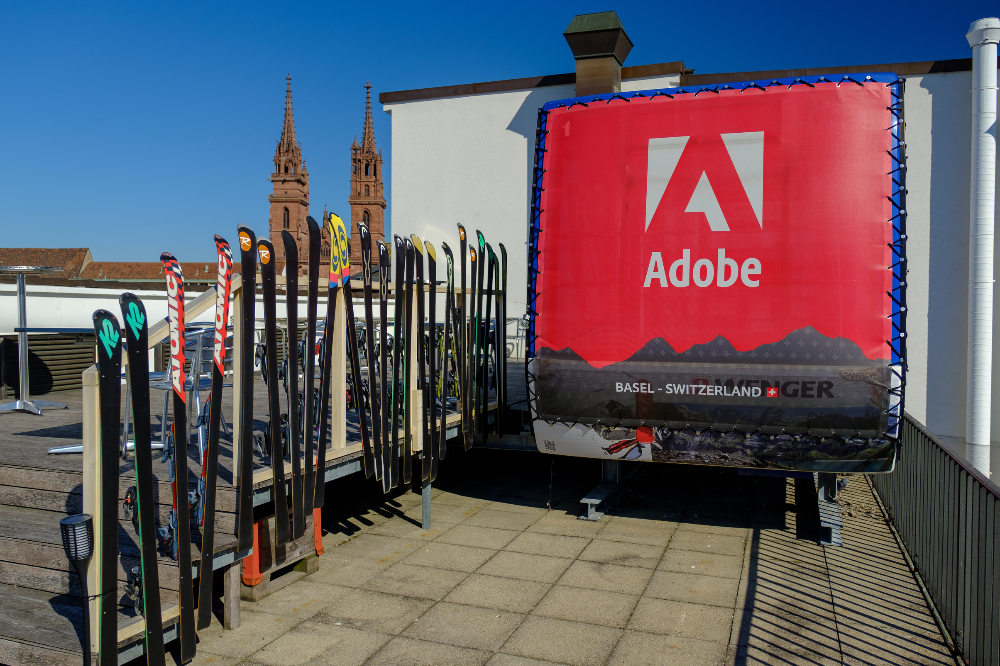Culture and technology evolving together
At its Basel research hub, Adobe is focusing its efforts on enhancing its existing Adobe Experience Manager product. This work is progressing against a backdrop of tension between the desire for rapid technological development and the need to make technological decisions with long-lasting ramifications.
 Geburtsort so manch guter Idee - die Adobe Dachterasse (© Greg Klebus)
Geburtsort so manch guter Idee - die Adobe Dachterasse (© Greg Klebus)
Adobe acquired Basel-based Day Software in 2010. The Adobe Experience Manager (AEM), which emerged from its predecessor ECMS (Enterprise Content Management System) – Communiqué – has now become a core component of the US company’s global offering and a significant source of revenue. All staff remained with the company following the takeover, and AEM continues to be developed primarily in Basel to this day, meaning it is still a Swiss-made product – a product undergoing development against a backdrop of tensions between the simultaneous desires for new technologies and continuity.
The elements that will play a key part in Adobe’s future strategy will certainly include cloud services, its serverless platform, the React framework, microservices, Node.js, and JavaScript. These are state-of-the-art technologies and provide exciting work for the development team. However, these new components need to fit into the company’s overall plan. “As much as we love technology, we have to remind ourselves not to alienate less agile enterprise customers and need to be able to guarantee a certain degree of continuity,” says Raphael Wegmüller, Director of Engineering at Adobe. “This is also in our own interest, as our strategic technology decisions will have ramifications for the next ten to fifteen years.”
Every voice matters
The long-term product vision is set at the management level, while the local team is in charge of the technical implementation. Every voice is listened to here – including everyone from principal scientists to junior developers – whether they make their thoughts known over a beer, on Slack, or via a technical whitepaper. Technology can be an emotional subject for developers, so things can get heated at times. Fortunately, the company has a solid and time-tested culture of discussion, which can be seen in full bloom on Open Fridays: Once a month, developers can spend time working on their own ideas, which occasionally end up as features on the official roadmap.
Aside from detailed plans and extensive discussion, it’s also important to take controlled risks. “That’s the only way to stay ahead – particularly in the fast-paced IT sector. Companies who play it too safe always lose in the end,” says Wegmüller.
Shifting the culture
Up to now, this has been an advantage for AEM. The company put their faith in the Java platform right back in its early days, and established a standard for creating and managing content repositories. The UI focus on ‘mobile first’, starting in 2012, also turned out to be well advised.
A cultural reorientation is currently taking place in parallel to these technological changes. There is a shift away from development teams with separate quality assurance or operations staff and movement towards DevOps – a team in which different skill sets coexist. “Our focus is on spotting and honing T-shaped skills. Developers’ core skills are in the long bar, but they should be able to slip into multiple roles on the horizontal in the medium term.”
The fact that the small but perfectly formed Basel team can act independently to make decisions with global reach is also apparent from how the AEM’s VP is based in Basel rather than the United States.
-->Table of contents show detail hide detail
- Index: -->Details
- Editorial: What do developers think? -->Details
- Basic Information -->Details
- How we do tech - Abacus -->Details
- Developer Profile -->Details
- How we do tech - approppo -->Details
- Programming, scripting and markup languages -->Details
- How we do tech - Opacc -->Details
- Frameworks, libraries and tools -->Details
- How we do tech - Adobe -->Details
- Databases -->Details
- How we do tech - Adcubum -->Details
- Platforms -->Details
- How we do tech - Trivadis -->Details
- Preferences and tools -->Details
- Carreer Aims + Opportunities -->Details
- Ethics & Technology Trends -->Details